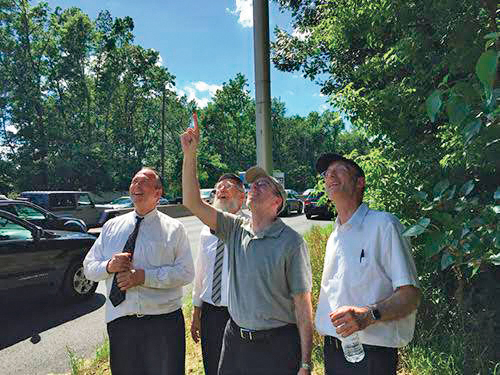How a chance encounter led to an inspirational and educational experience.

“The eruv is not kosher!”
Not the words you ever want to hear, especially less than 36 hours before Shabbos. But here I was on some random street in New Milford, with the foremost local eruv expert in town saying that this needs to be fixed immediately or thousands of Jews will be unable to carry that Shabbos, or worse, many Jews unaware and still carrying. A major issue.
So how did I end up in this situation?
It all started with my attendance at a sheva brachos which Rabbi Jachter happened to attend as well. He was talking about one of his recent eruv-checking trips (he apparently checks around 60 eruvin a year across the world). On a whim, I asked him when the next time he will be checking the Teaneck eruv, and to my surprise, he said tomorrow morning! I asked him if I could tag along, and he said of course.
The next morning, we drove and walked the northern part of the Teaneck eruv, to ensure that all was good. Little did we expect (and I guess that’s the reason why the eruv is checked every Thursday or Friday) that we would run into a major issue.
Around 20 minutes into our walk-around, we noticed a telephone pole that usually has a lechi (strip of plastic, metal or wood representing a door post running from the ground up until the eruv) that was missing. Not only that, but the whole telephone pole seemed to have been recently replaced. You could tell by the fresh ground that was recently displaced and the new-looking pole that was not weather-worn yet.
Of course, Rabbi Jachter immediately phoned in the issue to ensure that a new lechi would be installed before Shabbos. Problem solved, b”H.
Besides that excitement, here are a few other tidbits of information that I learned about the Teaneck eruv:
The eruv actually consists of two adjacent eruvin (one to the south and one to the north of Route 4) with five crossing points between the two traversing Route 4.
There are actually very clever mini-eruvin on the traverses of both sides of Route 4 to enable us to carry either under or over Route 4. (There is a halachic debate on whether or not Route 4 can be part of the eruv.)
The eruv mostly consists of telephone poles and wires, which are very convenient and reliable (less chance of them coming down).
At times, there are a poles, wires, or blocks of wood that the committee puts up in a few spots, as well as tzuros hapesach (resembling two doorposts and a lintel) and even some creative solutions like large mounds and fences
The committee running the eruv is constantly looking to upgrade it and is trying to adhere to many chumros as well.
For example, in my walk with Rabbi Jachter, he would point out that over here we are doing this to accommodate Rabbi Schachter’s chumra, over there Rabbi Willig’s chumra, and over here Rabbi Taubes’ chumra.
The eruv itself covers a pretty large section of Teaneck, Bergenfield and New Milford:
In the north, the eruv goes all the way down to Madison Avenue at the edge of New Milford/Dumont.
The border on the east consists of Woodbine Avenue, Teaneck Road and Columbus Drive.
To the south, Fort Lee Road in Bogota, and
To the west, the length of River Road.
I would definitively say that accompanying Rabbi Jachter for a few hours and hearing what goes into making, maintaining and upgrading the eruv has provided me with a greater sense of appreciation for all the work that gets done behind the scenes, allowing us to enjoy the fruits of their labor with a greater oneg Shabbos.












